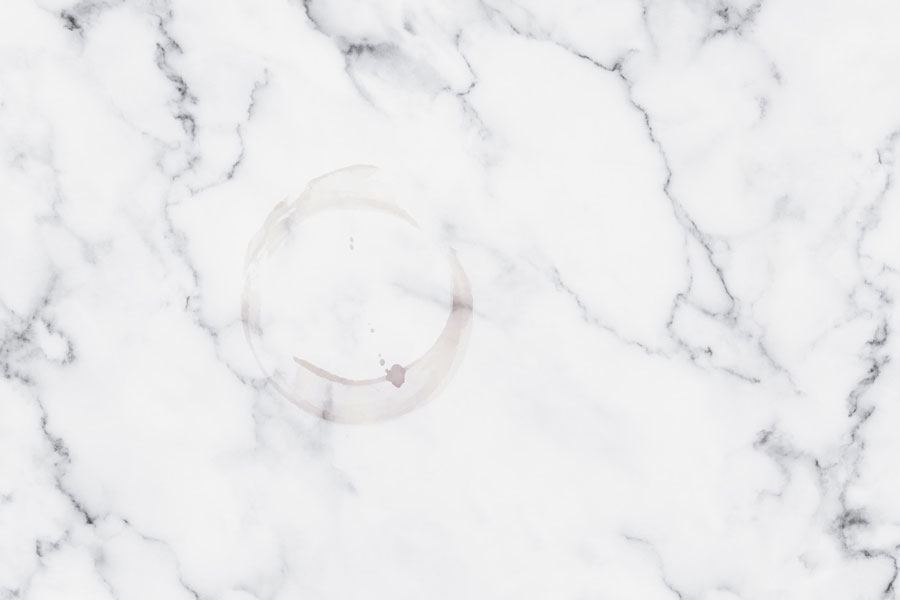If you’re wondering how to remove stains from marble benchtops, you’ve come to the right place.
As a seasoned expert with over ten years in stone care, I’ve honed the art of erasing even the most stubborn stains from marble surfaces.
Ready to restore your benchtops to their former glory? Let’s jump in.
Marble Stain Removal Essentials
Knowing how to remove stains from marble benchtops starts with understanding the stone’s nature.
Marble, a metamorphic rock, is valued for its beauty and elegance but is also porous, making it susceptible to staining. Immediate action is crucial when spills occur. The longer a substance sits on the surface, the more likely it is to penetrate and cause a lasting stain.
Here’s a checklist to help you assess and prepare for cleaning:
- Identify the type of marble.
- Determine the finish of your marble (polished or honed).
- Check for any existing sealant on the marble surface.
Identifying Marble Stains
Now let’s pinpoint the types of stains you’re dealing with on your marble benchtops.
Identifying the type of stain on your marble benchtops is essential for choosing the right removal method. Common stains include oil-based (like grease or cooking oil), organic (from food, coffee, or wine), ink, paint, and rust. Each type of stain has its own specific removal technique, which we’ll cover in detail.
Different stains require different approaches. Use this checklist to identify and categorize the stain for proper treatment:
- Oil-based stains (e.g., grease, cooking oil)
- Organic stains (e.g., coffee, wine, fruit)
- Inorganic stains (e.g., ink, paint)
- Rust stains
Immediate Marble Stain Removal Actions
When a spill happens, blot—don’t wipe—the area with a clean, dry cloth to remove stains from marble benchtops and prevent the spill from spreading. Avoid using harsh chemicals or abrasive cleaners, as these can etch the marble’s surface. For oil-based spills, a mixture of baking soda and water can create a paste that lifts the stain when left to sit for several hours or overnight.
Acting quickly can prevent a stain from setting. Follow this checklist when you notice a spill:
- Blot the spill with a clean, dry cloth.
- Avoid using harsh chemicals or abrasive cleaning tools.
- Prepare a cleaning solution appropriate for the type of stain.
Comprehensive Marble Stain Removal Steps
This is crazy: most marble benchtop stains can be removed with just a few household supplies.
For organic stains, hydrogen peroxide is a safe and effective cleaner. Apply it to the stain and cover with plastic wrap to prevent evaporation. Leave it for a few hours before wiping away. If the stain persists, a poultice made from a mixture of a solvent (like hydrogen peroxide) and an absorbent material (like talc) can draw out the stain.
Here’s a step-by-step checklist for tackling various types of stains on your marble benchtops:
- For oil-based stains: Apply a baking soda paste and leave overnight.
- For organic stains: Use hydrogen peroxide and cover with plastic wrap.
- For rust stains: Consider a commercial rust remover suitable for marble.
- For stubborn stains: Create and apply a poultice.
Professional Tips to Remove Stains From Marble Benchtops
But here’s the kicker: Remove stains from marble benchtops effortlessly with these professional tips.
Experts in marble cleaning recommend cleaning marble with a pH-neutral cleaner specifically designed for stone. Avoid vinegar, lemon juice, or other acidic cleaners that can etch the surface. For regular maintenance, dusting with a soft cloth and cleaning with mild soap and water will keep your marble looking new.
Maintaining your marble benchtops requires regular care. This checklist will help you keep your marble in top condition:
- Clean spills immediately with a pH-neutral cleaner.
- Dust the surface regularly with a soft cloth.
- Avoid using acidic cleaning agents like vinegar or lemon juice.
Marble Benchtop Protection
Sealing your marble benchtops can provide an additional layer of protection against stains. Sealers fill the pores in the marble, creating a barrier that prevents spills from penetrating the surface. It’s recommended to reseal marble every 6 to 12 months, depending on the level of use and exposure to staining agents.
Protecting your marble from future stains is just as important as removing existing ones. Use this checklist to ensure your marble stays pristine:
- Seal your marble benchtops regularly.
- Use coasters and trivets to prevent etching and staining.
- Conduct a yearly inspection to assess the need for professional maintenance.
Conclusion
We’ve covered a lot of ground today, from identifying different types of marble stains to the immediate actions you can take to prevent them from setting in. We’ve also walked through a comprehensive stain removal process and discussed the importance of regular maintenance and protection to keep your marble benchtops looking their best.
Remember, the beauty of marble is timeless, and with the right care, your benchtops can remain a stunning centerpiece in your home for years to come. So, don’t let those pesky stains intimidate you. With this guide and your newfound knowledge, you’re more than equipped to tackle them head-on.If you’re interested in learning more about removing marble stains, you can also check this article.
Happy cleaning, and here’s to many more years of pristine marble in your home!
